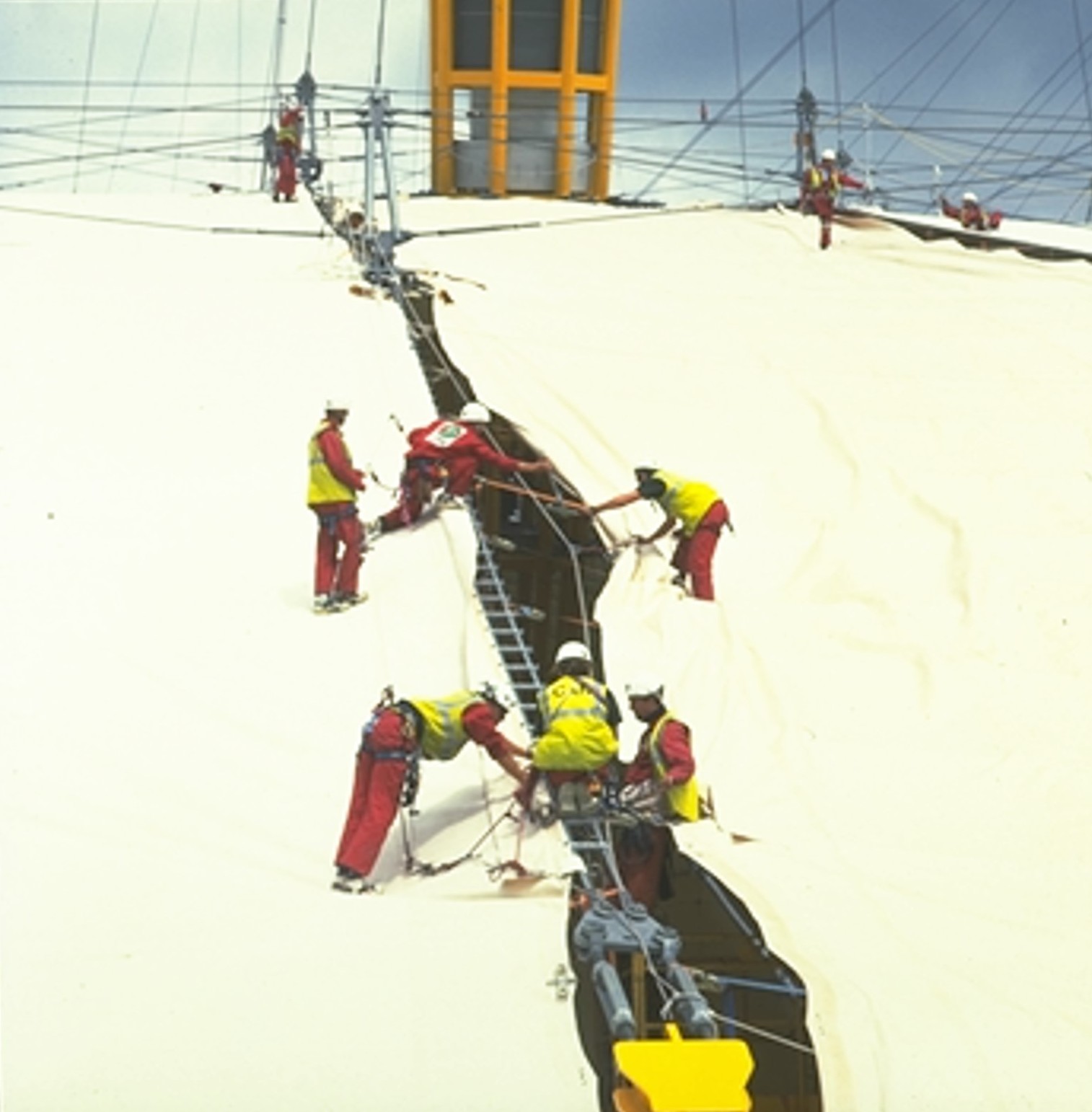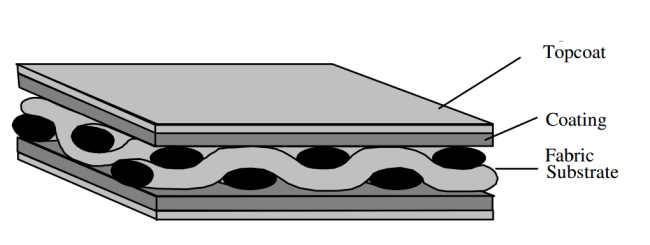Architectural fabrics
Contents |
[edit] Introduction
The term ‘architectural fabrics’ generally refers to structural fabrics used to form tensile surfaces, such as canopies, roofs and other forms of shelter. Architectural fabrics are generally held in position by tension forces imposed by a structural framework, a cabling system, internal air pressure or a combination.
Typically, the membrane is formed by a fabric, consisting of a woven base cloth, coated on both sides with an impermeable polymer, and sometimes a durable topcoat, however a wide range of variations are available, ranging from open weave fabrics, to transparent foils.
Architectural fabrics are generally very thin, approximately 1mm thick and have very little compressive strength, but very high tensile strength.
The typical tensile strengths of architectural fabrics are set out below:
- Type 1: 3,000 N/5cm.
- Type 2: 4,000 N/5cm.
- Type 3: 5,550 N/5cm.
- Type 4: 7,000 N/5cm.
- Type 5: 9,000 N/5cm.
[edit] Cotton
Cotton was one of the earliest materials used as an architectural fabric, and is still in use today. It is relatively inexpensive and is available in a wide range of colours, but it has a lower tensile strength than some more modern materials, and is prone to staining and shrinkage. It has a relatively short life expectancy, but can flex repeatedly without cracking, and so tends to be used for small-scale, temporary structures.
[edit] PVC polyester
PVC coated polyester is the most commonly used architectural fabric. It is relatively inexpensive, has reasonable structural strength and translucency, can be joined relatively easily at seams by welding, and has an reasonable life expectancy.
Structurally, PVC polyester can last in excess of 20 years, however, it becomes more difficult to clean as the plasticisers used to make the PVC flexible leach to the surface, and so it is generally expected to last 10 to 15 years.
It is often manufactured with a topcoat such as PVDF (polyvinylidene fluoride), which improves its cleanability, but generally reduces its weldability, and so must be removed in the region of welded seams. Topcoats can increase the lifespan of PVC polyester to 15 to 20 years.
NB: PVC has been criticised for its environmental performance, with claims that the chemicals used to plasticise the PVC can be harmful to the environment. However, alternatives such as polyolefin coated polyester have struggled with fire resistance issues, and fire retardants added to the coating have resulted in reduced adhesion at seams.
[edit] PVC nylon
The less common PVC nylon is similar to, but has a higher elasticity than PVC polyester, and so has been used for the fabrication of air-supported and air-inflated structures.
[edit] PTFE glass
PTFE (polytetrafluoroethylene or ‘Teflon’) coated glass can be stronger than PVC polyester, and is longer lasting, with a life in excess of 30 years. However, it is more expensive and is relatively inelastic, and so requires more accurate patterning.
PTFE is a cream colour when new, but bleaches white in sunlight and is generally self cleaning if regularly exposed to sunlight.
[edit] Silicone glass
Whereas PTFE is translucent, silicone is transparent, and silicone coated glass has an anticipated life of up to 50 years. It has good fire resistance and low toxicity, but is not weldable, and so the seaming process requires an adhesive, and silicone can be difficult to keep clean.
[edit] EFTE foil
Ethylene tetrafluoroethylene (ETFE) is a relatively transparent foil that can be used as a lightweight alternative to glass. It can be used as a single layer, or in multiple layers of up to 5 layers, inflated to form large cushions.
[edit] Others
Other materials that have been used, sometimes only for experimental purposes, or in forms that were discontinued include:
[edit] Uncoated fabrics
- Linen.
- Woven PTFE fibre (hydrophobic, microporous, durable and with approximately 40% light transmittance).
- High-density polyethylene (HDPE is not waterproof and is seamed by sewing).
[edit] Films
- Polyethylene.
- PVC.
- Polyester.
- FEP (fluorinated ethylene propylene).
- ETFE.
- PTFE.
- Vinyl.
- PVF.
[edit] Mesh reinforced films
- Polyester reinforced PVC.
- Glass reinforced FEP.
- Aramid reinforced FEP.
- Steel reinforced FEP.
- Glass reinforced ETFE.
- Aramid reinforced ETFE.
- Steel reinforced ETFE
- Polyester reinforced ETFE.
- Glass reinforced PTFE.
[edit] Coated fabrics
- Acrylic painted cotton.
- Vinyl coated cotton.
- High Silica Fabrics.
- Hypalon coated polyester.
- Neoprene coated nylon.
- Hypalon coated nylon.
- Polyolefin coated polyester.
- Polyester coated cotton.
- PTFE coated polypropylene.
- PTFE coated polyester.
- PTFE coated acrylic.
- ETFE coated glass.
- ETFE coated polyester.
- PVF coated glass.
- PTFE coated aramid.
- PVC coated aramid.
- PVDF coated polyester.
- PVDF coated glass.
- Vermiculite coated glass.
- Vinyl coated nylon.
- Vinyl coated polyester.
- Vinyl laminated polyester.
- Acrylic coated polyester.
- Polyurethane coated nylon.
[edit] Multilayer and enhanced membranes
- Double layer fabrics.
- Triple layer fabrics.
- Inflated cushions.
- Active membranes.
- Insulated fabrics.
- Phase change fabrics.
[edit] Related articles on Designing Buildings Wiki
- Air-supported structure.
- Anticlastic.
- Buckminster Fuller.
- Coating.
- ETFE.
- Fabric structures.
- Frei Otto.
- Glass reinforced concrete.
- Inflatable building.
- Millennium Dome.
- Phase change materials.
- Polyethylene.
- Polyvinyl chloride PVC.
- PTFE.
- Rubber.
- Silicon.
- Ted Happold.
- The development of structural membranes.
- The history of fabric structures.
- The structural behaviour of architectural fabric structures.
- The thermal behaviour of spaces enclosed by fabric membranes.
Featured articles and news
Boiler Upgrade Scheme and certifications consultation
Summary of government consultation which closes 11 June 2025.
Deputy editor of AT, Tim Fraser, discusses the newly formed society with its current chair, Chris Halligan MCIAT.
Barratt Lo-E passivhaus standard homes planned enmasse
With an initial 728 Lo-E homes across two sites and many more planned for the future.
Government urged to uphold Warm Homes commitment
ECA and industry bodies write to Government concerning its 13.2 billion Warm Homes manifesto commitment.
Places of Worship in Britain and Ireland, 1929-1990. Book review.
The emancipation of women in art.
CIOB Construction Manager of the Year 2025
Just one of the winners at the CIOB Awards 2025.
Call for independent National Grenfell oversight mechanism
MHCLG share findings of Building Safety Inquiry in letter to Secretary of State and Minister for Building Safety.
The Architectural Technology Awards
AT Awards now open for this the sixth decade of CIAT.
50th Golden anniversary ECA Edmundson awards
Deadline for submissions Friday 30 May 2025.
The benefits of precast, off-site foundation systems
Top ten benefits of this notable innovation.
Encouraging individuals to take action saving water at home, work, and in their communities.
Takes a community to support mental health and wellbeing
The why of becoming a Mental Health Instructor explained.
Mental health awareness week 13-18 May
The theme is communities, they can provide a sense of belonging, safety, support in hard times, and a sense purpose.
Mental health support on the rise but workers still struggling
CIOB Understanding Mental Health in the Built Environment 2025 shows.
Design and construction material libraries
Material, sample, product or detail libraries a key component of any architectural design practice.
Construction Products Reform Green Paper and Consultation
Still time to respond as consultation closes on 21 May 2025.
Resilient façade systems for smog reduction in Shanghai
A technical approach using computer simulation and analysis of solar radiation, wind patterns, and ventilation.



























Comments
That's a great and elaborate article on Architectural fabrics that I've so far read. I like how you scientifically described everything so the readers can easily understand. Your different kinds of fabric lists are extremely helpful for further studies. But maybe you could add some examples and history of architecture fabrics.
See: